State Farm Bundle
Who Really Owns State Farm?
Unraveling the intricacies of corporate ownership is key to understanding a company's core values and strategic direction. For a giant like State Farm, the question of ownership goes beyond simple shareholders, impacting everything from customer service to financial performance. Established in 1922, State Farm's unique structure has shaped its journey to becoming a leading insurance provider. Understanding the State Farm SWOT Analysis can further illuminate its position.
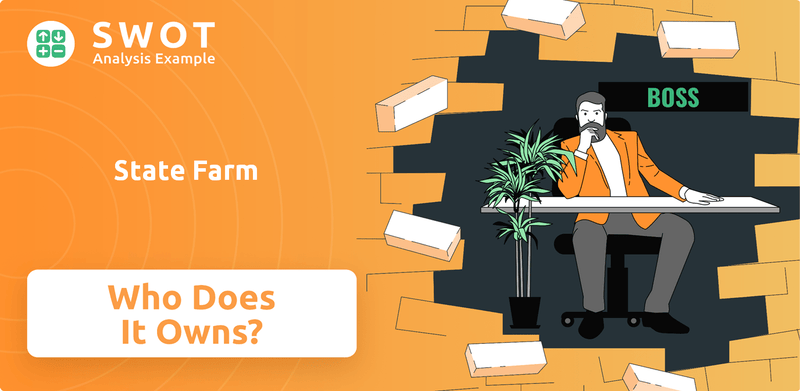
State Farm's evolution, from its inception by George J. Mecherle to its current status as a major player in the insurance industry, is a story of innovation and adaptation. The company's financial health, demonstrated by its 2024 net income of $5.3 billion and a net worth of $145.2 billion, highlights its robust position. This exploration into State Farm ownership will examine its mutual structure, the role of policyholders, and the influence of its Board of Directors, offering insights into how it operates.
Who Founded State Farm?
The story of State Farm begins in June 1922, with George J. Mecherle, a retired farmer and insurance agent, at the helm. Mecherle's vision was to establish a mutual automobile insurance company. This structure meant that the company would be owned by its policyholders, a key element in its early success and lasting impact on the insurance industry.
This ownership model was designed to benefit customers directly. Profits were returned to policyholders through lower premiums and enhanced coverage. Initially, State Farm focused on insuring farmers, who were considered lower risk. This strategic focus allowed the company to offer competitive rates, setting the stage for its growth.
Early sales strategies involved recruiting respected individuals within communities as part-time agents. These agents, often local farm bureau officials or school principals, played a crucial role. They generated sales volume by offering affordable insurance packages. Unlike traditional stock companies, State Farm, as a mutual company, could adjust premiums or refund surpluses to policyholders, reflecting its commitment to customer-centric practices. The company expanded its offerings to include homeowners and life insurance by 1935, broadening its scope and appeal.
Founded in June 1922 by George J. Mecherle.
A mutual company, owned by its policyholders.
Focused on auto insurance for farmers.
Utilized part-time agents from local communities.
Expanded to include homeowners and life insurance by 1935.
Leadership included George Mecherle's son, Ramond Mecherle, and members of the Rust family.
Understanding the State Farm ownership structure is key to grasping its operational philosophy. The mutual structure has allowed State Farm to prioritize its customers, a strategy that has contributed to its long-term success. For more insights into its competitive environment, consider reading about the Competitors Landscape of State Farm.
- State Farm insurance began with a focus on auto insurance, specifically for farmers.
- The company's early success was driven by a customer-centric approach, with profits reinvested in policyholders.
- State Farm executives like George Mecherle and later, members of the Rust family, shaped the company's direction.
- The mutual ownership model ensured that the company's interests aligned with those of its customers.
State Farm SWOT Analysis
- Complete SWOT Breakdown
- Fully Customizable
- Editable in Excel & Word
- Professional Formatting
- Investor-Ready Format
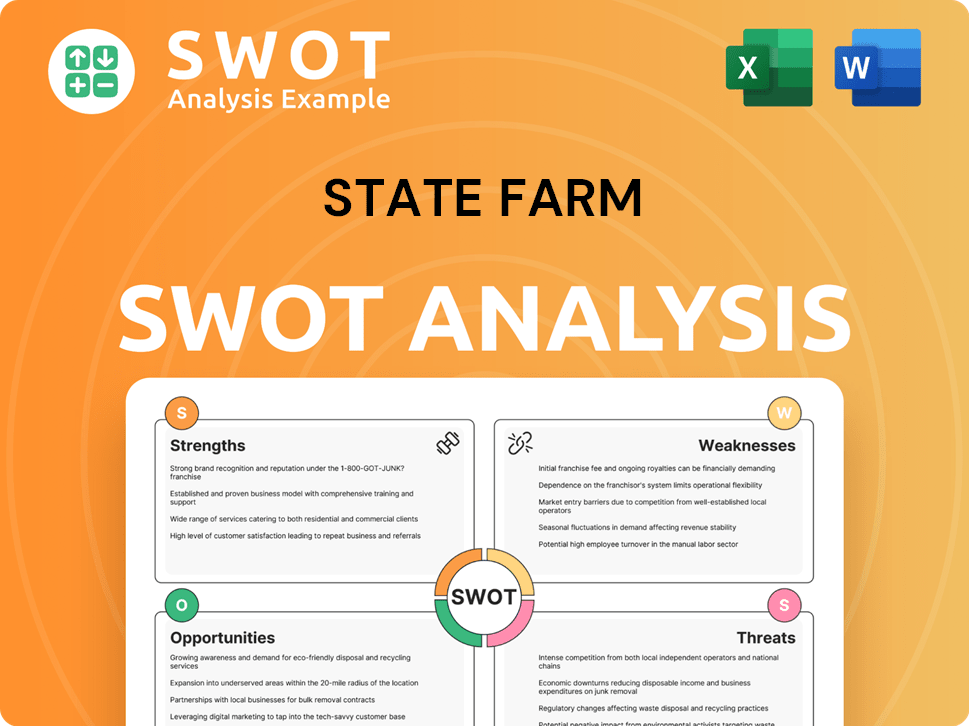
How Has State Farm’s Ownership Changed Over Time?
The evolution of State Farm ownership is rooted in its mutual structure, established in 1922. This structure means that State Farm is owned by its policyholders, a key differentiator from competitors like Allstate and Progressive, which are publicly traded. This model allows profits to be reinvested or returned to policyholders through lower premiums or enhanced services. Understanding who owns State Farm is crucial for grasping its operational priorities and financial strategies.
State Farm's structure has remained consistent, emphasizing policyholder ownership. The company operates as a group, with State Farm Mutual Automobile Insurance Company at its core. This structure includes wholly-owned subsidiaries such as State Farm Fire and Casualty Company and State Farm Life Insurance Company. This setup influences how the company allocates resources and makes strategic decisions, focusing on long-term value for its policyholders rather than short-term gains for external shareholders. The Marketing Strategy of State Farm reflects this focus on customer-centricity.
| Year | Key Event | Impact on Ownership/Structure |
|---|---|---|
| 1922 | State Farm Mutual Automobile Insurance Company founded | Established mutual ownership structure, policyholder-owned. |
| Ongoing | Expansion into various insurance and financial services | Growth of subsidiaries, maintaining mutual ownership. |
| 2024 | Financial Performance | Property and casualty earned premiums reached $103.0 billion, life insurance premium income of $6.7 billion, and individual life insurance in force at $1.2 trillion. |
While policyholders technically own State Farm, their direct influence is limited. Unlike public companies where shareholders actively vote, policyholders' voting power is often not fully exercised. This can give State Farm executives and management significant autonomy. The management's decisions are primarily guided by the company's mission to serve its policyholders, ensuring stability and long-term value. The company's financial performance in 2024, with substantial premium income and dividends, highlights the success of this structure.
State Farm is a mutual company, owned by its policyholders, not shareholders. This structure influences its financial strategies and commitment to customer service.
- Policyholders own the company.
- Profits are reinvested or returned to policyholders.
- Subsidiaries operate under the mutual structure.
- Management has significant autonomy in decision-making.
State Farm PESTLE Analysis
- Covers All 6 PESTLE Categories
- No Research Needed – Save Hours of Work
- Built by Experts, Trusted by Consultants
- Instant Download, Ready to Use
- 100% Editable, Fully Customizable
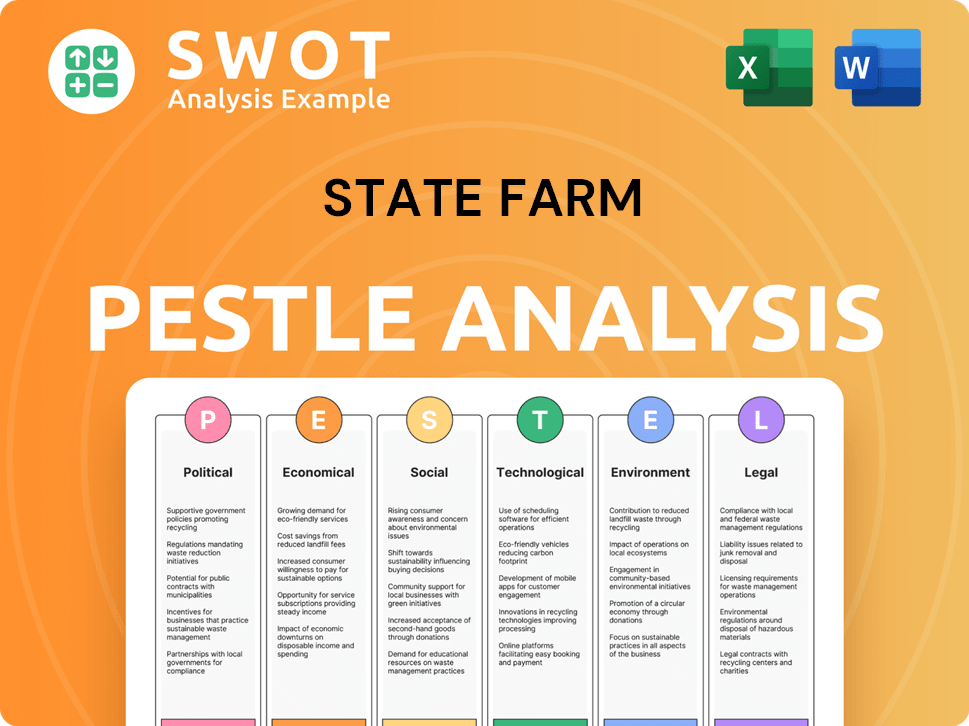
Who Sits on State Farm’s Board?
Understanding the State Farm ownership structure is key to grasping its governance. As a mutual company, Who owns State Farm is a fundamental question answered by its policyholders. These policyholders collectively own the company, which shapes the role and responsibilities of the Board of Directors. The board's primary duty is to represent the interests of these policyholders, ensuring the company operates in their best interest.
While specific details about the current board members and their affiliations are not readily available in public search results, the core principle remains that the board is accountable to the policyholders. This structure differs significantly from publicly traded companies where shareholders elect the board. The unique State Farm insurance model grants policyholders a voice in the company's direction, although the extent of their direct involvement is limited in practice.
| Board Member | Title | Affiliation |
|---|---|---|
| Information not available publicly | Information not available publicly | Information not available publicly |
| Information not available publicly | Information not available publicly | Information not available publicly |
| Information not available publicly | Information not available publicly | Information not available publicly |
The voting structure within State Farm company, as a mutual, typically grants policyholders one vote per household or per the first-named insured. This 'one-vote-per-household' system means that the number of policies held or the duration of the customer relationship does not affect voting power. Although policyholders have the right to vote and elect the board, direct involvement in governance is often limited. This model grants significant power to State Farm executives, who are not subject to the same pressures from external shareholders as in publicly traded companies. For a deeper dive into the company's financial operations, consider exploring the Revenue Streams & Business Model of State Farm.
State Farm ownership rests with its policyholders, not external shareholders.
- The Board of Directors represents policyholder interests.
- Voting is typically 'one vote per household'.
- Executives have significant authority due to the mutual structure.
- Direct policyholder involvement in governance is often limited.
State Farm Business Model Canvas
- Complete 9-Block Business Model Canvas
- Effortlessly Communicate Your Business Strategy
- Investor-Ready BMC Format
- 100% Editable and Customizable
- Clear and Structured Layout
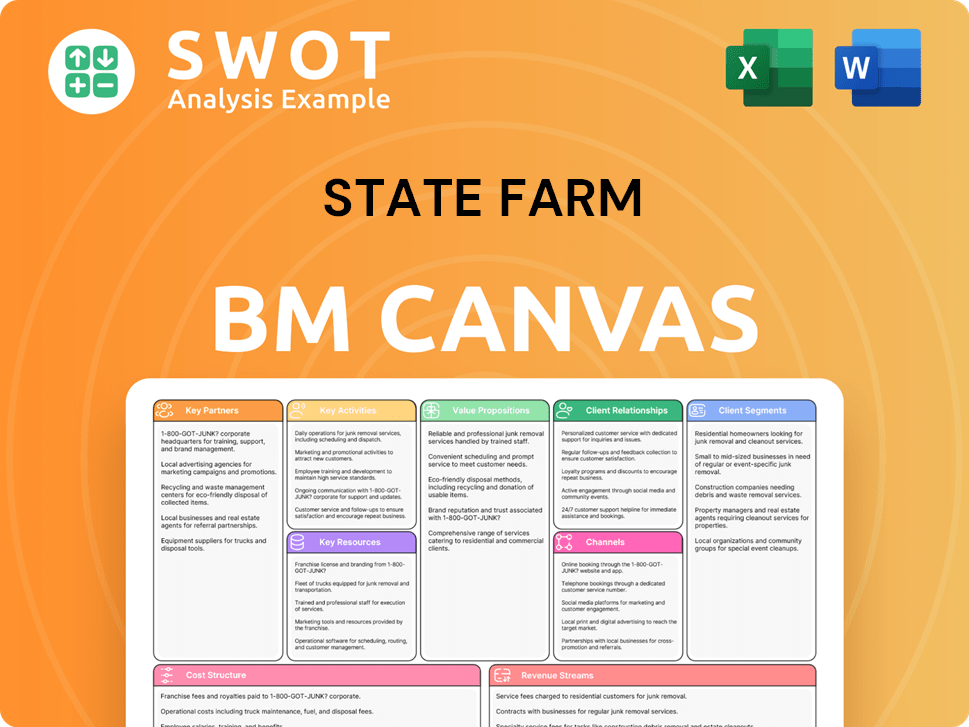
What Recent Changes Have Shaped State Farm’s Ownership Landscape?
Recent developments at State Farm, a mutual company, showcase its resilience and strategic adaptations. In 2024, the company reported a net income of $5.3 billion, a significant improvement from a $6.3 billion net loss in 2023. This turnaround was largely due to better auto underwriting results, even with increased homeowners' catastrophe claims. The company's property and casualty earned premiums increased to $103.0 billion in 2024, up from $87.6 billion the previous year. The net worth of State Farm Mutual Automobile Insurance Company reached $145.2 billion by the end of 2024, demonstrating solid financial health. These figures highlight the company's continued strength in the insurance market.
As of April 2025, State Farm holds a leading position in the U.S. insurance market. It maintains an 18.9% market share in auto insurance and an estimated 19.4% of the total homeowners direct premiums collected in 2024. The company's strategy of relying on its network of over 19,000 captive agents remains a key differentiator. These agents are crucial for maintaining customer relationships and providing localized service, contributing to State Farm's ability to retain a significant market share.
| Metric | 2023 | 2024 |
|---|---|---|
| Net Income/Loss (Billions) | -$6.3 | $5.3 |
| Property and Casualty Earned Premiums (Billions) | $87.6 | $103.0 |
| Net Worth (Billions) | $134.8 | $145.2 |
State Farm continues to invest in technology to improve its operations and customer service. This includes using drone technology for property inspections and leveraging AI and machine learning for underwriting and claims processing. A notable investment was the $1.2 billion equity investment in ADT Inc. in September 2022, along with a $300 million opportunity fund to explore new technologies. These moves reflect a shift towards proactive loss prevention, which is part of the company's broader strategy. Read more about the Growth Strategy of State Farm.
State Farm is a mutual company, meaning it is owned by its policyholders, not by external shareholders. This structure allows the company to prioritize the needs of its customers over maximizing profits for shareholders.
The current CEO of State Farm is Michael Tipsord. He leads the company in its strategic direction and ensures its continued success in the insurance market. The leadership team is focused on adapting to market changes.
The State Farm company headquarters is located in Bloomington, Illinois. This location serves as the central hub for the company's operations and strategic decision-making.
No, State Farm is not a public company. It operates as a mutual company, owned by its policyholders, which means its shares are not traded on public stock exchanges.
State Farm Porter's Five Forces Analysis
- Covers All 5 Competitive Forces in Detail
- Structured for Consultants, Students, and Founders
- 100% Editable in Microsoft Word & Excel
- Instant Digital Download – Use Immediately
- Compatible with Mac & PC – Fully Unlocked
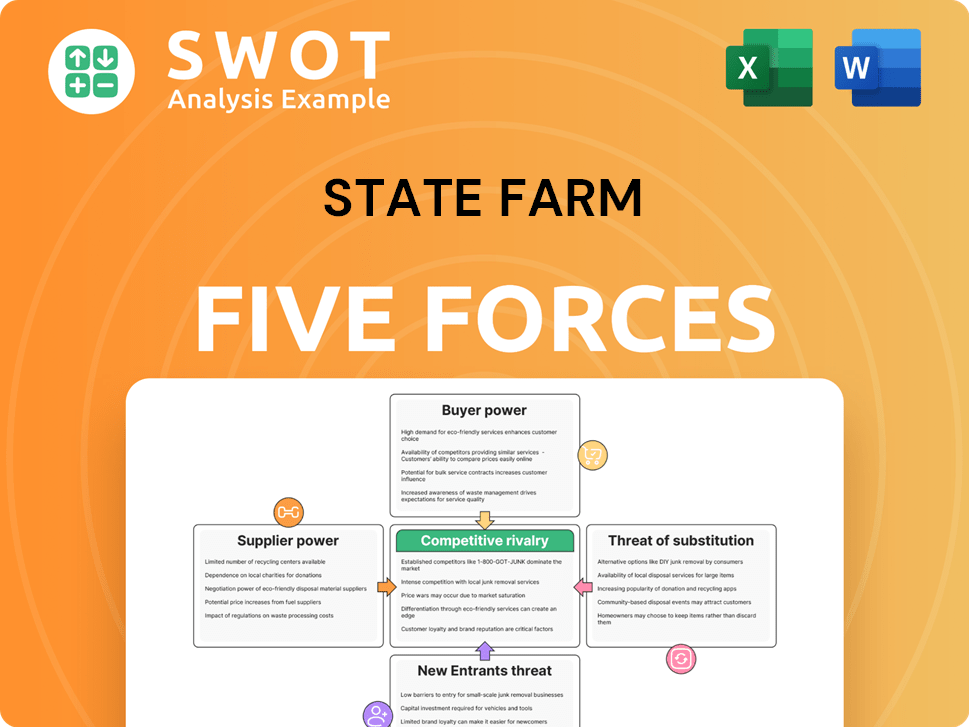
Related Blogs
- What are Mission Vision & Core Values of State Farm Company?
- What is Competitive Landscape of State Farm Company?
- What is Growth Strategy and Future Prospects of State Farm Company?
- How Does State Farm Company Work?
- What is Sales and Marketing Strategy of State Farm Company?
- What is Brief History of State Farm Company?
- What is Customer Demographics and Target Market of State Farm Company?
Disclaimer
All information, articles, and product details provided on this website are for general informational and educational purposes only. We do not claim any ownership over, nor do we intend to infringe upon, any trademarks, copyrights, logos, brand names, or other intellectual property mentioned or depicted on this site. Such intellectual property remains the property of its respective owners, and any references here are made solely for identification or informational purposes, without implying any affiliation, endorsement, or partnership.
We make no representations or warranties, express or implied, regarding the accuracy, completeness, or suitability of any content or products presented. Nothing on this website should be construed as legal, tax, investment, financial, medical, or other professional advice. In addition, no part of this site—including articles or product references—constitutes a solicitation, recommendation, endorsement, advertisement, or offer to buy or sell any securities, franchises, or other financial instruments, particularly in jurisdictions where such activity would be unlawful.
All content is of a general nature and may not address the specific circumstances of any individual or entity. It is not a substitute for professional advice or services. Any actions you take based on the information provided here are strictly at your own risk. You accept full responsibility for any decisions or outcomes arising from your use of this website and agree to release us from any liability in connection with your use of, or reliance upon, the content or products found herein.